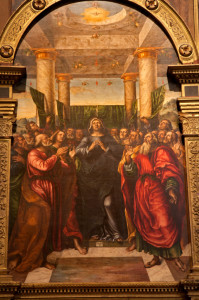Pentecost Sunday is one of the most important days of the year in the Christian Church. It always occurs 50 days, or seven weeks, after Easter. Pentecost means “50” in Greek. The holiday is a moveable feast, meaning the date is different each year. In 2015, Pentecost Sunday falls on May 25. Sometimes referred to as “the birthday of the church,” it is considered by many Christians to be the third most holy date after Easter and Christmas.
Pentecost was originally a Jewish holiday and harvest festival. It also commemorated the day God is believed to have given Moses the 10 commandments on Mount Sinai. Jews still celebrate Pentecost 50 days after Passover.
In the Christian tradition, it has a different meaning. According to the Bible, Jesus knew he was going to die and told his disciples that the Holy Spirit (God) would come to them after he did, and provide comfort and guidance. Pentecost is the day this happened.
Pentecost in the Bible
Acts 2:1–4 describes God’s arrival on Pentecost:
“When the day of Pentecost came, they were all together in one place. Suddenly a sound like the blowing of a violent wind came from heaven and filled the whole house where they were sitting. They saw what seemed to be tongues of fire that separated and came to rest on each of them. All of them were filled with the Holy Spirit and began to speak in other tongues as the Spirit enabled them.”
Wearing Red
Red is the color of Pentecost; it represents fire and the pleasure of God. The clergy wear red vestments, altars are typically draped in red cloths and red banners are frequently hung from ceilings and on walls. Red candles and flowers may also be used as decorations. Sometimes members of the congregation dress in red as well. The color also symbolizes the approaching warmth of summer.
Pentecost Around the World
In a number of European countries including France, Germany, Greece and Norway, the Monday after Pentecost is a public holiday. Pentecost is also celebrated in a variety of ways including:
The blowing of trumpets at French church services to represent the strong wind that accompanied God when He descended to the Earth.
Rose petals are scattered from the ceilings of Italian churches to evoke the phenomenon of the tongues of fire.
In northwestern England, there are church parades that feature choirs, brass bands and girls dressed in white. These festivities are called Whit Walks.
Pentecost is also a day often reserved for baptisms, particularly in Northern Europe. Traditionally, baptisms took place outside and required full immersion in water. It was much more likely to be warm in late spring than at other times of the year.
Famous Paintings of the Pentecost
A number of well-known artists have created depictions of Pentecost. They include:
Giotto
The Italian artist Giotto painted his Pentecost around 1305 and it is in the Scrovegni Chapel in Padua, Italy.
Titian
Titian’s Pentecost (c. 1545) hangs in the Santa Maria della Salute church in Venice, Italy.
El Greco
El Greco’s Mannerist masterpiece The Pentecost (c. 1596) can be seen at the world famous Prado Museum in Madrid, Spain.
Peter Paul Rubens
Flemish Master Peter Paul Rubens’s Descent of the Holy Spirit (c. 1619) hangs in the Neuburg Palace, Neuburg State Gallery, Germany.
Pentecostalism
Pentecostalism is an evangelical type of Protestantism that appeared at the beginning of the 20th century and is named after Pentecost. Two somewhat controversial practices of the religion are speaking in tongues and divine healing (also called faith healing). The worldwide number of Pentecostals is estimated to be over 279 million.


